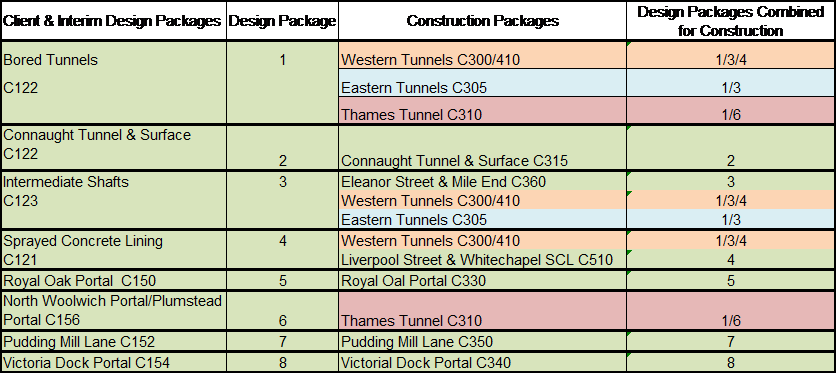
The use of CEEQUAL in complex projects
Document
type: Micro-report
Author:
Mike de Silva BSc PhD FCIWEM MIEEM CSci C.WEM
Publication
Date: 27/09/2016
-
Abstract
CEEQUAL has been used as a tool to benchmark overall environmental performance for Crossrail’s tunnels, portals and shafts. One of the key challenges was the alignment of design packages with the procurement and construction strategy. This paper focuses on the key issues and provides suggestions on how the process can be simplified. The paper also addresses the issue of the value of CEEQUAL in driving best practice and overall improvement on a high profile major infrastructure project that is required to deliver high levels of performance through its minimum environmental requirements and rigorous consenting process.
-
Read the full document
Introduction and Industry Context
The developers and owners of CEEQUAL describe it as an evidence-based sustainability assessment, rating and awards scheme for civil engineering, infrastructure, landscaping and the public realm, that celebrates the achievement of high environmental and social performance. CEEQUAL is an independent third party scheme now wholly owned by the BRE. One of its stated aims is to deliver improved project specification, design and construction of civil engineering works. CEEQUAL claims to reward project and contract teams in which clients, designers and contractors go beyond the legal, environmental and social minima to achieve distinctive environmental and social performance in their work. In addition to its use as a rating system to assess performance, CEEQUAL is intended to provide significant influence to project or contract teams as they develop, design and construct their work, because it encourages them to consider the issues in the question set at the most appropriate time.
Crossrail decided to adopt CEEQUAL for its tunnels, portals and shaft structures which represent a mixture of diaphragm wall and piled structures, sprayed concrete lining structures and bored tunnels.
It should be noted that the experience detailed in this paper refers to CEEQUAL version 4. Subsequent versions of CEEQUAL are now in use and the purchase of CEEQUAL by BRE in November 2015 has signalled that significant changes are likely within the next 2 years. Certain principles identified herein, may still help to guide the user in the appropriate strategy for assessing packages on complex major projects
Context
Early on in the project implementation phase a decision had to be made on how to apply CEEQUAL to the eight Crossrail civil design packages which consisted of separate portal, tunnel (both bored and Spray Concrete Lining) and shaft designs. Each of the packages was assigned to a different design team, although there was a key element of interface management throughout. Columns 1 and 2 of Table 1 show how the different packages were allocated to different design teams. Each CEEQUAL assessment reflected the scope of the particular package and was assessed at Client & Interim Design stage. Client & Interim Design was essentially at RIBA D/D+. All the assessments were formally assessed and rated as Excellent on completion of this stage.
Whilst the designs were in progress, however, decisions were being made regarding the construction procurement strategy. The finalisation of that strategy resulted in the combining of certain elements that had been assessed separately under the CEEQUAL process together in a single construction contract (see Table 1 below) which then had to be assessed to give a final Whole Project Award CEEQUAL certificate on completion of construction.
Table 1. Depiction of design packages and how they were combined into construction packages for CEEQUAL whole project award.
The final construction procurement strategy for Crossrail therefore resulted in some rather difficult decisions as to how best to combine the individual CEEQUAL scores obtained at Client & Interim Design stage into the Whole Project Award, which is only obtained on completion of construction. Fortunately for Crossrail the Client & Interim Design awards were all Excellent and therefore the process was made easier. However, care still had to be taken to ensure that performance at one particular location was not unduly affecting the performance at another location during the combining of Client & Interim Design stage CEEQUAL scores. For example, the Intermediate shafts design package (C123) covered several individual shafts located over a wide geographic area and the Client & Interim Design Stage assessment was scored across all the shafts. However, the western running tunnel construction package (C300/410) included the western running tunnels (designed by C122) and the Fisher Street shaft (designed by C123) and thus the running tunnel Client & Interim Design assessment had to be combined with the Client & Interim Design stage assessment for Fisher Street shaft, which itself formed part of an assessment that encompassed all the shafts. An assessment therefore had to be made as to whether there were particular environmental issues associated with Fisher Street shaft that affected, positively or negatively, the overall score when combined with the running tunnel score.
In addition, because the design that was the basis of the Interim & Client Award was at RIBA D/D+ when it was handed over the contractor, it was not possible to close out many of the design credits beforehand. This resulted in a “gap” in design credit evidence that now formed part of the construction phase that contributed to the Whole Project Award. Because the design liability continued to lie with the design consultant this resulted in the Crossrail client team having to continue working with the design consultant to ensure those credits were obtained at the same time as working with the Contractor so that overall, between the two, all credits necessary for the Construction Award could be obtained. This is illustrated Figure 1 below. Furthermore, specific client input was required where Crossrail was seen to have a “controlling mind” on issues such as Community Engagement/Relations and where there was overlap in areas such as the Community Investment Programme.
Figure 1: Crossrail evidence split for Client & Interim Design and Construction Awards
In some cases, finishing works on Crossrail such as landscaping will be completed by others and not the main contractor. This has resulted in an issue with the overall scope of CEEQUAL assessment whereby the contractor for a physical asset is not always able to provide the full evidence for all aspects of the project of works. This will either:
- require a CEEQUAL assessment handover back to the Crossrail client, which will need to either manage the remainder of the assessment or instruct it to be completed by the contractor that is carrying out the landscape works.
- Require a scoping out of this element of the work providing a rather incomplete picture of overall performance
- Require an “in good faith” statement from the client that an appropriate restoration scheme in accordance with the credit requirements will be undertaken
Lessons Learned
- If a decision is made to use an assessment methodology such as CEEQUAL during design, it may often be made while there is still limited knowledge of the construction procurement strategy. The latter is complex and will evolve as the project thinking matures in order to provide the optimal outcomes in terms of programme and cost. This can result in the need to split out, reassign and combine Client & Interim Design Assessment evidence in order for this to be combined with the Construction award evidence to enable an assessment for Whole Project Award.
- Depending upon the project programme, the design may not be complete at the time of going to tender and the procurement of the contractor. Also, unless it is specifically transferred to the contractor, the design liability for that incomplete design will still lie with the designer. If a Client & Interim Design award is sought for the design at the tender stage, this means that the Construction award, which is the responsibility of the contractor, will also include design credits which must be sought through the designer whilst the construction credits are sought through the Contractor. This adds complexity to the process resulting in added management resource from the client to bridge the gap between the designer and the contractor.
- Irrespective of whether the design is complete at the time of going to tender, it is often the case (as with Crossrail) that mechanical & electrical and architectural designs are taken through to RIBA D/E by the initial designers, with contractors developing the designs to RIBA F prior to approval and procurement. This too can add complexity to the Construction Award assessment process.
- Finishing works such as landscaping are often completed by others and not always the main contractor. This also creates an issue with the overall scope of CEEQUAL assessment whereby the contractor for a physical asset is not always able to provide the full evidence for all aspects of the project. This would require a CEEQUAL assessment handover back to the client, which would need to either manage the remainder of the assessment or instruct it to be completed by the landscape contractor. In reality it is not practical to implement the latter and it is suggested that an “in good faith” statement from the client that an appropriate restoration scheme in accordance with the credit requirements will be undertaken could be provided. This option is similar in practice to such statements made under BREEAM where letters of intent signed by a senior authority are acceptable for certain credits.
It is suggested that if this option is chosen, the assessing organisation (in this case CEEQUAL) may choose to delay the ratification process until such works are completed. Provided that the overall credit score is not marginally above a particular rating band and reliant on these outstanding credits, this would still provide certainty to the client of the expected rating which may be contractually binding, prior to the formal contract completion.
Recommendations for Future Projects
Where possible, it is recommended that an Interim Client & Design award is scoped to include full design. Ideally, this would be completed before going out to tender, however, where this is not possible due to programme pressures or procurement strategy, then a Client and Interim Design Stage assessment should still be undertaken, followed by a separate contractor assessment that includes any remaining design elements and construction. This is illustrated in Figure 2.
Figure 2: Illustrated Recommendation for the scope of the Client & Interim Design and Construction Awards
In summary, to simplify the process of evidence gathering and the interdependency of Interim and Whole Project certification, consideration should be given to agreeing a strategy with CEEQUAL Ltd in advance that the Client & Interim Design and the Construction awards be kept distinct with the former including all the design (at least to RIBA E) where possible [1], thereby creating a clearer definition in scope and less reliance on the contractor to require information from the client and designer.
[1] It is acknowledged that certain projects may be tendered as a reference design, in which case appropriate design credits can still be transferred into a stand alone contractor only award
-
Authors
Mike de Silva BSc PhD FCIWEM MIEEM CSci C.WEM - Bechtel
Sustainability Manager
Mike has over 25 years of environmental and sustainability design and construction experience much of which has been gained in the rail industry. He has worked on the two largest rail link projects in the United Kingdom, Crossrail and High Speed 1. Mike worked as Sustainability Manager on the Crossrail between 2009 and 2017 and was responsible for delivering its sustainability strategy and reporting as well as leading on CEEQUAL and BREEAM project management, and had an assurance role on the management & measurement of the project’s carbon footprint. He is currently working on HS2 Phase 2b.
He is well known in the industry and has published a number of works including the well reviewed Royal Institute of Chartered Surveyors publication “Sustainability & the Property Lifecycle”. He has also sat on a number of working groups including CEEQUAL International, BREEAM Infrastructure and BES6001 a voluntary standard on responsible sourcing of construction materials & products, and is currently on the editorial panel for the ICE Journal, Engineering Sustainability.



